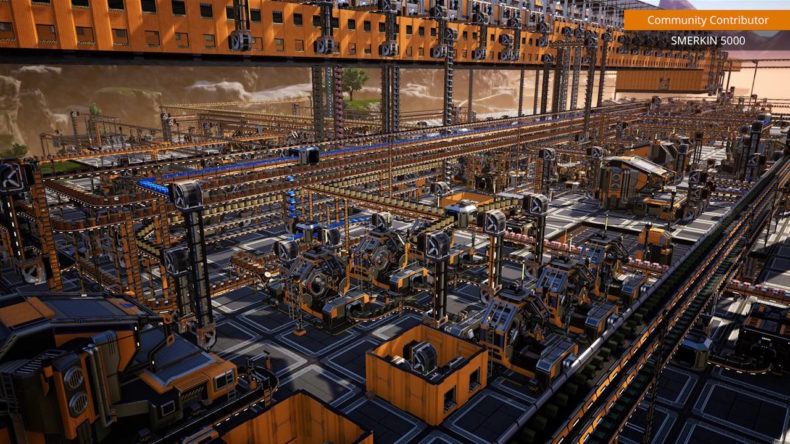Welcome to part 2 of our Satisfactory interview with Snutt Treptow, Community Manager at Coffee Stain Studios. In part one of our interview, we talked about how Snutt recommends you play Satisfactory as well as the big content additions that came with Update 8. You can go and check it out here.
In Part 2, we first turn our attention to the Satisfactory community, and how blown away by it Snutt and the team are on a continual basis. We’ll also discuss some tips and tricks that the community itself has discovered and one I got to try out firsthand. Let’s jump back in.
Satisfactory Interview with Snutt Treptow – Part 2
We turn our attention to the community of Satisfactory, next, and it’s clear this is something Snutt is very appreciative of. Following on from introducing the new Buildable – the Priority Power Switch – in Part 1, Snutt discusses what the community then did with this new toy.
“It’s cool the community managed to do that”
“One really cool thing that I don’t know if we intended for is where you can interact with them from a distance. If you place multiple Priority Power Switches, you can actually just be at one place and you can interact with the other ones from a distance, in the menu. You can turn them off and on in this general power circuit.”
“And one really cool thing that people started doing was they would set up their factory in such a way where they were factory would be producing specific parts and then they would get everything behind different fuse groups. So one fuse group for making Screws and one fuse group for making Modular Frames or whatever. And then when they were building stuff in the distance and they run out of a material, they would normally have to run back to, they would have a Priority Power Switch where they’re building and they would go to that and turn on that group, whatever part they’re missing.”
“And they would have train networks run and set up so that they would transport the specific part that they’re needing to them. And that’s, that’s that’s that’s something that I think we intended, just a really cool idea.”
I asked him about the community input and what really blows him away, and Snutt replied with:
“The scale of it, of what people make. I feel like this [the Priority Power Switch train idea] is something that the design team could have been “Yeah, this is now I think potentially possible, but we don’t know specifically how to set it up.” So it’s cool that the community managed to do that.”
“And it doesn’t break anything. It’s just a fun thing”
Buoyed by our conversation regarding the community, Snutt continues discussing another community-found addition to the game, that I can’t wait to try out myself.
“Another good example is for instance when we made the hypertubes, some people figured out that if you just put multiple entrances, you can get way more speed. And they create these like cannons with hypertubes. And that was definitely not intended, but that was a very welcoming addition to the game. And it doesn’t break anything. It’s just a fun thing. So we decided to just leave that bug as it is.”
“And when we implemented Update Eight and upgraded to Unreal Engine Five, we had to replace the entire physics engine actually. So like all the physics in the game has been completely reworked and the hypertube cannon broke when we did that. So we actually had to implement that bug and get it working again.
“It’s like it’s like as far as we know, that’s now a feature in the game. We have to support that.”
I admitted to Snutt, that whilst I’d heard of these souped-up hypertubes online, I’d never actually used one myself. Luckily, there was one in his world close by. He pointed out that this was a “mini” version of what some people have done in the community. The more entrances you stack together, the faster it goes. His example had three entrances stacked, whereas others in the community had ten or twenty stacked to live up to the “cannon” moniker. I stepped in and can confirm the speed increase. I can only imagine what 20 stacks feel like to whoosh through.
Clearly inspired by our speedy traversal, Snutt and I then discuss jetpacks for a couple of minutes as Snutt reminisces about previous QOL improvements to the game, most notably the ability to set your jetpack fuel, to have easier whizzing around the landscape, and it is clear this is something at the forefront of the team’s mind – how can we make this game more enjoyable for fans.
“We were always trying to push against that a lot for a long time”
Snutt then began building in front of me, briefly discussing blueprints and changes there, and doing so I noticed him lay multiple foundations at once in a row to get a large platform to build stuff on, so that he could show me what he was meaning. And I had to interject. I remember laying foundations for hours, creating multi-level factories that we flat and orderly, and each single concrete slab having to be laid one at a time. It took time, but made the end result all the more pleasing, for the time it took. I mentioned this to Snutt, whilst he was burrowing away and he stopped to chat.
“Right? That’s actually something that’s kind of interesting because we were always trying to push against that a lot for a long time.”
It seems taking the decision to lay multiple foundations – as opposed to other quality of life additions wasn’t an easy decision. Snutt continues:
“There’s a lot of stuff that people in the community requested that they were always like “You don’t really want to do that because it kind of breaks some of the stuff that we like about Satisfactory”. I think we always went to the approach with Minecraft where, when you look at a factory in a distance, you know that like, “Oh, I placed every single building block there and then I put in all the effort over there.” We were scared that if we add something where you can mass build or you know, even blueprints – that was also something we were against for a long time – if we make it too easy for people to play the game, they’ll sort of lose out on like what the game is about. So we’ve tried to find the good middle ground.”
“It is easier because for instance the zapping thing is like on foundation pieces and stuff like that, because that’s something that you place a lot more of. We’ll add it to that and just retain it for factory buildings. And with the Blueprint mode, for instance, that’s the same thing. We didn’t want it so that people could just like take entire factories, just copy, paste it and, you know, make infinite factories and yeah, so we design it so you have a limit, right? You can place anything within these like four by four grid and you know, and then you can use that. And that also adds like another type of gameplay on top of it that I think was really interesting where you kind of want to design your blueprints for like a modular approach and try and place them together.”
“It’s almost like a mini-game within the game”
We double down on discussing blueprints now, as Snutt continues discussing how they’ve changed the approach the how Satsifactory is played.
“There are people that have made their entire factory using that mindset of all this. There’s one YouTuber, in particular, is called Yakez and he’s made, this entire series of just using blueprints to make entire factories. So all of his buildings use blueprints and they’re all modular. And in his own words, it’s like I had to I had to completely re-change and completely rethink how to build factories.”
“It’s a limitation, but at the same time, it adds a lot of depth to the game. It’s almost a mini-game within the game to figure out how to fit them and all that stuff and make factories, you know, be expandable. You still need to hook up your different modules. So that aspect is still there. So we still retain the aspect of building, but it’s a lot simpler.”
I interject here, again with my memories of Satisfactory. I would spend far too long calculating the perfect set up for mergers and splitters, and being able to copy and paste setups – albeit small ones – with blueprints is a clever step, as you’re saving time without hampering the creativity. Snutt agrees and quickly shows me a few examples of lined-up splitters, or even Constructors lined up that can be saved and used for later. It can be as complex as you want it to be.
And that concludes Part 2 of our Satisfactory Interview with Snutt Treptow. If you want to check out the third and final part of our Satisfactory Interview with Snutt, or go and remind yourself of Part 1, you can click on the links below.
PREVIOUS: CLICK HERE FOR PART 1
NEXT: CLICK HERE FOR PART 3






